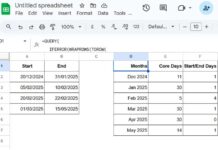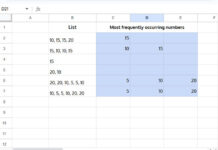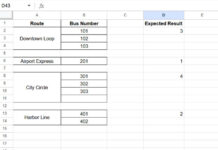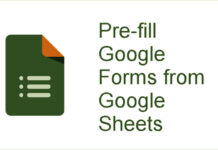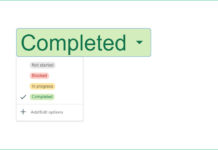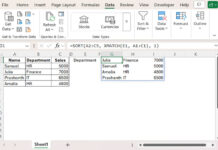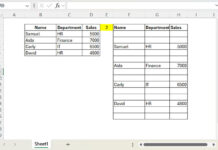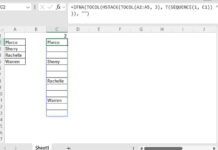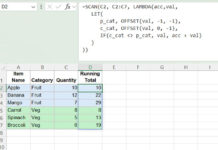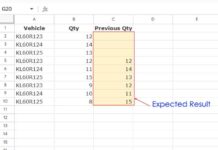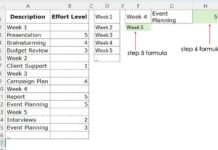To sum multiple sum columns in DSUM, you can combine it with SUMPRODUCT in Google Sheets. This method offers an advantage over SUMIFS, allowing you to apply multiple criteria while summing multiple columns dynamically.
The key is to specify the columns to sum as an array and wrap DSUM inside SUMPRODUCT.
Generic Formula
=SUMPRODUCT(DSUM(A1:D, {"field 1", "field 2", "field 3", ...}, F1:F2))Where:
- A1:D: Data range
- {“field 1”, “field 2”, “field 3”, …}: Field labels of the columns to sum
- F1:F2: Criteria range
Example: Summing Multiple Sum Columns in DSUM
Sample Data
The dataset includes student names (Column A) and their marks in three subjects (Columns B–D).
| Name | Maths | Physics | Chemistry |
| Rose | 90 | 86 | 90 |
| Rose | 94 | 80 | 89 |
| Rose | 96 | 79 | 91 |
| Mike | 98 | 89 | 75 |
| Mike | 97 | 82 | 78 |
| Mike | 98 | 84 | 89 |
We will sum the total marks of “Rose” in all three subjects.
Step-by-Step Guide
1. Define the Criteria
- Enter “Name” in F1 (criteria label).
- Enter “Rose” in F2 (criteria value).
2. Enter the DSUM Formula
In H2, enter:
=SUMPRODUCT(DSUM(A1:D, {"Maths", "Physics", "Chemistry"}, F1:F2))
Alternative Approach: Using Column Numbers
Instead of using column names, you can refer to the column positions:
=SUMPRODUCT(DSUM(A1:D, {2, 3, 4}, F1:F2))How the Formula Works
1. DSUM with Multiple Sum Columns
When specifying multiple sum columns like {“Maths”, “Physics”, “Chemistry”} or {2, 3, 4}, DSUM returns separate totals for each column.
However, DSUM alone does not sum them together, so we wrap it inside SUMPRODUCT.
2. Why Use SUMPRODUCT Instead of SUM?
While you can use SUM with ARRAYFORMULA, SUMPRODUCT simplifies the formula:
=SUM(ARRAYFORMULA(DSUM(A1:D, {2, 3, 4}, F1:F2)))Can be replaced with:
=SUMPRODUCT(DSUM(A1:D, {2, 3, 4}, F1:F2))Key Benefits:
- Shorter & cleaner formula
- No need for ARRAYFORMULA
- Handles arrays efficiently
Dynamic Approach: Sum Multiple Columns in DSUM with SEQUENCE
If you have several continuous columns to sum, manually listing them can be tedious. Instead, use the SEQUENCE function to generate field numbers dynamically.
Formula Using SEQUENCE
=SUMPRODUCT(DSUM(A1:D, SEQUENCE(3, 1, 2), F1:F2))How It Works
SEQUENCE(3, 1, 2)generates{2, 3, 4}dynamically.- The formula sums 3 continuous columns starting from the 2nd column (Maths).
Adjusting for More Columns:
Change 3 to the total number of columns, and 2 to the first column’s position.
Conclusion
By using SUMPRODUCT with DSUM, you can efficiently sum multiple sum columns in DSUM while applying criteria dynamically.
Key Takeaways:
- Use column labels or numbers in DSUM
- Wrap DSUM in SUMPRODUCT for correct totals
- Use SEQUENCE for dynamic column selection
This method is powerful for conditional summing across multiple columns in Google Sheets.
Resources
- DSUM with Multiple Criteria – AND, OR Logic Explained
- How to Use Date Difference as Criteria in DSUM in Google Sheets
- Difference Between SUMIFS and DSUM in Google Sheets
- Comparing SUMIFS, SUMPRODUCT, and DSUM with Examples
- How to Properly Use Criteria in DSUM
- Perform a Case-Sensitive DSUM in Google Sheets
